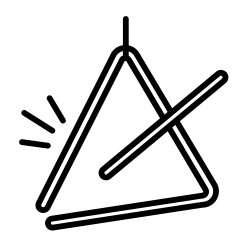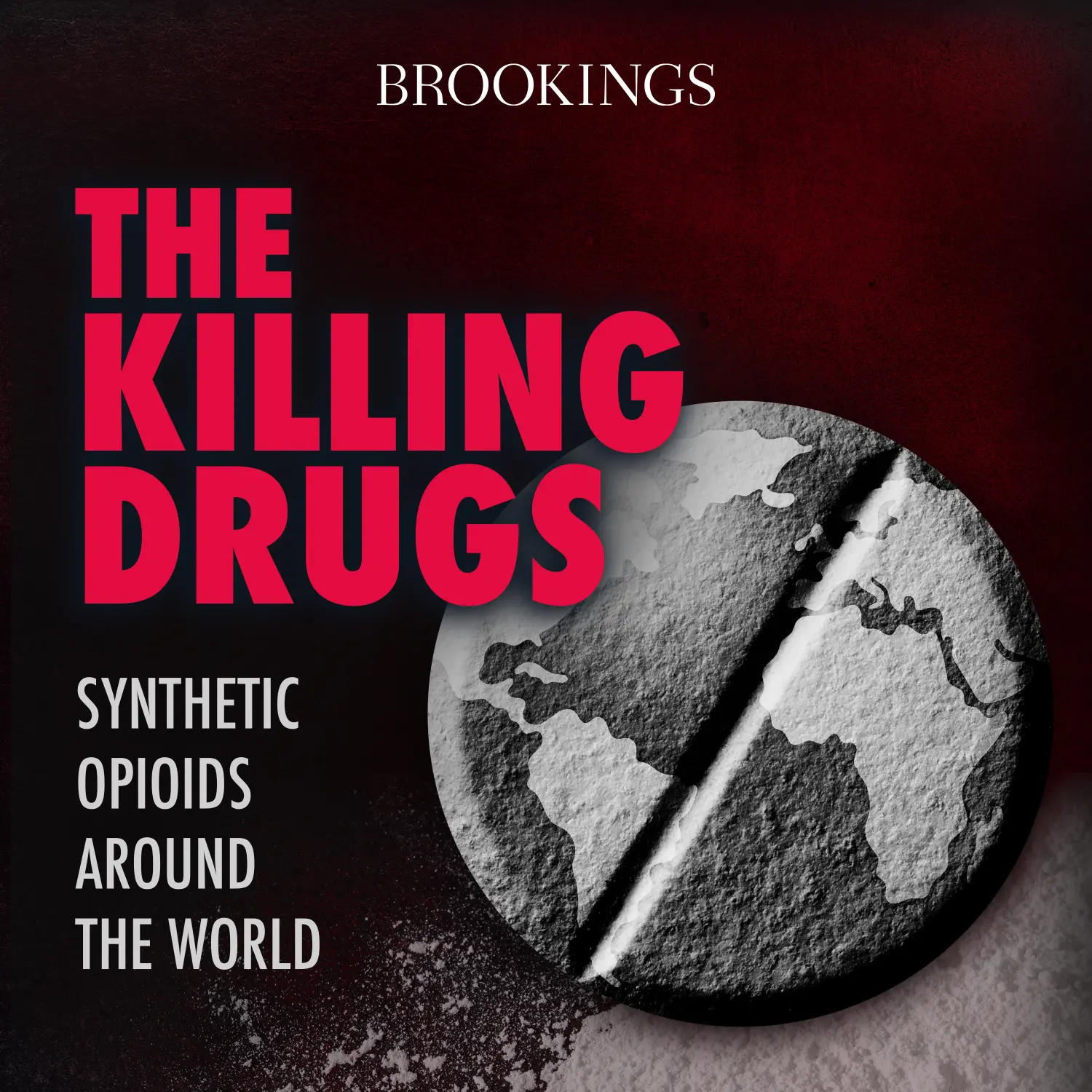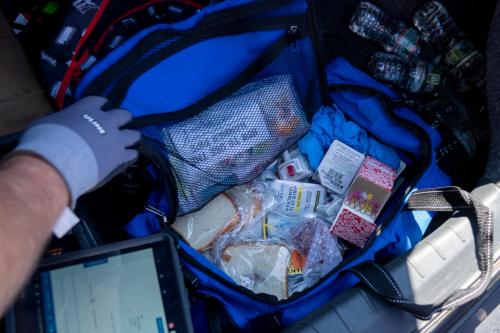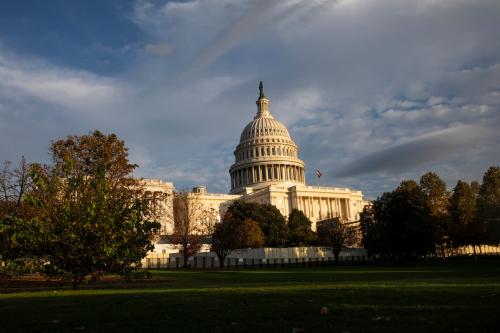In this episode, host Vanda Felbab-Brown discusses the benefits and limitations of harm reduction approaches with experts Regina LaBelle and David Holtgrave, who discuss a wide scope of harm reduction measures, including naloxone provision, overdose prevention centers, and the importance and efficacy of client-centered and community-centered approaches. Felbab-Brown, LaBelle, and Holtgrave also explore the legal barriers and stigma that pose challenges to adopting these strategies in the United States.
- Listen to The Killing Drugs on Apple, Spotify, or wherever you like to get podcasts.
- Watch episodes on YouTube.
- Learn about other Brookings podcasts from the Brookings Podcast Network.
- Sign up for the podcasts newsletter for occasional updates on featured episodes and new shows.
- Send feedback email to [email protected].
Transcript
[music]
FELBAB-BROWN: I am Vanda Felbab-Brown, a senior fellow at the Brookings Institution. And this is The Killing Drugs. With more than 100,000 Americans dying of drug overdoses each year. The fentanyl crisis in North America, already the most lethal drug epidemic ever in human history, remains one of the most significant and critical challenges we face as a nation. In this podcast and its related project, I am collaborating with leading experts on this devastating public health and national security crisis to find policies that can save lives in the United States and around the world.
On today’s episode, we are talking about harm reduction. My guests are Professor Regina LaBelle, director of the Addiction and Public Policy Initiative and the O’Neill Institute for National and Global Health Law at Georgetown University Law Center, and a former acting director of the Office of National Drug Control Policy, where she served during 2021. As well as Doctor David Holtgrave, an adjunct professor with the Department of Health, Behavior and Society at Johns Hopkins Bloomberg School of Public Health and a former senior associate director of the Office of National Drug Control Policy between 2022 and 2024. The paper that they are contributing to this project is entitled “Harm reduction and its role in improving health outcomes in an era of fentanyl.”
Regina and David, thank you so much for joining me today.
LABELLE: Thank you, Vanda, for having us on today.
HOLTGRAVE: Thank you, Vanda. Thanks for this important conversation.
FELBAB-BROWN: So, Regina, let me start with you. When you were the acting director of the Office of National Drug Control Policy in 2021, after a distinguished career in that office, which is the highest coordinating body within the U.S. government focused on drug control policy, you pulled off something of a revolution by introducing the concept of harm reduction into an official U.S. government drug strategy. Please explain to us what is harm reduction.
[2:19]
LABELLE: Thanks so much for that question to lay the groundwork for the definition of harm reduction. So, harm reduction is both a philosophical belief in the fundamental humanity of every individual, as well as a long-accepted tenet of public health. So, public health is about promoting healthy outcomes and reducing the harms associated with certain activities. And what we’ve seen for harm reduction in the past includes wearing a bike helmet or seatbelts. But really, it’s also belief that all human beings deserve respect and should be treated with dignity. And in this case, what we’re talking about today is because a person may use drugs, may have chaotic drug use, or may have a substance use disorder.
So, the specific harm reduction tools and techniques that reduce the harms associated with substance use include naloxone. This is a drug that prevents overdoses, reverses overdoses, and prevents death. And it really wasn’t generally accepted publicly until about 2010 and after.
But harm reduction in this context also includes syringe services programs. So, these are places where people can go to receive sterile syringes as well as other health services. So, as we write in our piece, syringe services programs have been around since the ‘80s. They started in Europe in response to the HIV/AIDS epidemic. And syringe services programs have been shown through research to reduce blood borne diseases like HIV and Hep C without increasing drug use. They’re also places where people in need can get other services or referrals to services, and they may be the only place where someone can receive a kind word, and a variety of services that might include, something as simple as something to eat.
So, harm reduction programs help people who are facing inhumane circumstances, helps them receive humane services. They’re places where we meet people where they are, but we don’t leave them there.
FELBAB-BROWN: Thank you for explaining, at least in broad terms right now, and we’ll delve into details what are the various components of harm reduction strategies. And you mentioned that in Europe, some of these policies were commonplace or at least were being implemented and eventually became commonplace as early as 1980s. And yet I said that you had to pull off somewhat of a revolution in the U.S. government to get the terminology into the strategy of the Biden administration. Why was it so difficult to make this leap? You know, why was it a revolution to bring harm reduction into the policy?
[5:05]
LABELLE: Yeah, so, I think over time the term harm reduction has been thought of as enabling drug use. And, you know, again in the early days of the Obama administration, we had about 20,000 opioid-involved overdose deaths. They were primarily involving prescription opioids. And so, during that time I was working at the time for Gil Kerlikowske, who was the former police chief. And we worked really hard to reach out to law enforcement about the importance of naloxone, naloxone to reduce overdose deaths, to reverse overdoses. Naloxone was not generally accepted for lay use before about 2011, 2012.
So, in 2021, when I entered the Biden administration and we had reached 100,000 overdose deaths, you know, we really didn’t have a choice. Given the lethality of the drug supply, we weren’t in a place where we could just ask people, wait for them to raise their hand and ask for treatment, wait for people to ask for other services.
So, we know from surveys the majority of people with a substance use disorder don’t receive treatment. And this is for a number of reasons, including the fact that they may not think they need treatment. In our traditional response to drug use and substance use disorder has been very one size fits all and reliant upon law enforcement. So, that’s why this shift to acknowledge harm reduction as part of the continuum of care was so important, but also not easy. It took a long time to get it included and respected as part of the continuum of care.
FELBAB-BROWN: I was going to say, you know, the core of the objection was this notion that if using drugs is less risky, if people can reverse overdose, they will be using more drugs or more people will be using drugs.
And just to give our listeners a context here, you mentioned you were working with Mr. Gil Kerlikowske, who at the time was the director of the Office of National Drug Control Policy during the Obama administration.
So, David, you too were very much part of the effort to streamline harm reduction into U.S. government policies and beyond, into the practice on the ground that is so crucial for saving lives. Can you elaborate with us a bit more why has there been such a difference in attitudes between the United States and Europe? Why has there been so much more reluctance in the United States to move toward these policies that seem to be just intuitively making a lot of sense and that are backed up by evidence of directly saving lives and improving the quality of people’s lives.
[7:57]
HOLTGRAVE: Thank you, Vanda. I think as been hinted at already, a real central reason for that reluctance is a lot of division over what harm reduction actually means. And, as we’ve said, harm reduction really means listening to someone on their journey in life and providing client-centered services to address the negative consequences associated with substance use and to take the next steps toward enhancing health and well-being, including access to drug treatment when needed and as desired.
But some people tend to believe or assert that they believe that harm reduction means encouraging substance use and ignoring or minimizing the negative consequences of drug use. And that’s really not the case at all with harm reduction services. So, I believe it’s critical that we make concerted efforts, like in this discussion today, to be clear for a broader audience what harm reduction actually means and what harm reduction services actually do.
Secondly, I would say besides this definitional issue, we have to do even more to communicate about the very substantial body of research that shows that there are benefits to a number of harm reduction services and that some, quote unquote, feared consequences such as increased drug use tend not to occur with the provision of harm reduction. For instance, as Regina alluded to, syringe service programs have been shown to be able to reduce negative consequences of injection drug use such as by lowering HIV transmission by injection. And concerns about syringe service programs encouraging increases in drug use have really not transpired in carefully done studies. So, I think that’s also important.
And lastly, I would say that we have to be really clear that harm reduction goes so far beyond the substance use arena. For instance, public health work to lower tobacco use, to decrease infectious diseases, to improve auto safety, to improve cardiovascular health, and even to reduce cancer risk. All involve different types of harm reduction. But we don’t generally use the word harm reduction in those spaces. Indeed, seatbelts in your car are a type of harm reduction, but we don’t use that phrasing. And even in this space, I’ve been doing public health work for about 35 years, years ago, we too didn’t use the phrase harm reduction. That phrase has come along a little bit more recently than that.
FELBAB-BROWN: David, you are absolutely right that that term has become particularly explosive. I would note that this year for the first time, Secretary of State Blinken used the term in the U.S. government foreign presentation, the Vienna Meeting on drugs. Myself, I’m involved in various engagements and Track II with Chinese scholars, Chinese former government officials and, that same concern that you were voicing is there. You know, that they often tell me some of the policies you’re talking about make great sense, but we absolutely cannot use the term harm reduction. That is just too politically explosive even if we can push for policies that in their content are part of that.
Regina, I want to come back to you in a second, but I just want to follow up on one thing that you said, David. And that is, there is a strong body of evidence that the benefits are there. Can you describe some of the benefits? And I also want to highlight one component of what you said, which is listening to the client, to the customer, not thinking about the person who is suffering from substance use disorder as a criminal, not stigmatizing that individual, is crucially the core of harm reduction. Isn’t that the case?
[11:30]
HOLTGRAVE: Two great questions. I think on the issue of types of benefits, I think that we have seen over time—and in our paper we actually go into a lot of detail about the specific study, so more to be found there—but found that, for instance, syringe service programs tend to reduce HIV, provide a really important pathway to drug treatment services, as well as other kinds of medical services. Also, I think besides medical services, harm reduction can also be a very important pathway to linking persons to other services to address social determinants of health like unstable housing. And so, it also provides an important pathway, for instance, to housing services or food security services as well. So, again, lots more on the specific studies in the paper.
I would say to your second question about the client centeredness of harm reduction, it’s really important that we do even more work that uses mixed methods and ethnographic methods to listen to person’s individual stories. For instance, as xylazine has become to be an issue, with fentanyl adulterated with xylazine, a drug used as an animal tranquilizer, really listening to how people came to use xylazine, what it means, what reactions are to fentanyl adulterated with xylazine, and to wound care—the xylazine tends to be associated with very specific kinds of flesh wounds, and how someone can engage and be empowered to care for these wounds on their own, as well as access to medical care, to care for wounds as well. So, I think that that’s another important aspect of this and certainly invite Regina if there’s anything you’d like to add to this as well.
FELBAB-BROWN: Yeah, absolutely. Regina, you started talking about the panoply of harm reduction. Are there any specific ones beyond safe syringes beyond naloxone that you are speaking about that you want to highlight?
[13:23]
LABELLE: Yeah. I think what David said is really important. And when we wrote this piece and throughout our time in government, we made sure to involve people who are on the ground, who are working in harm reduction programs. Because our data, you know, our data lag. And we don’t always hear about what’s happening on the ground. And so, these types of programs can really help us be more responsive to needs.
But in terms of the specifics, I’ve mentioned naloxone, I mentioned syringe services programs. Another area that we worked to expand is drug testing. So, in the previous administration, there had been a ban on spending funds to test drugs. Because the reasoning was that there wasn’t going to be specific or precise enough, there was a risk of false positives about testing for fentanyl. We really believed that it was yet another tool that could be used to make sure that people are aware that what they might be getting could be adulterated with a lethal substance.
Now, we’ve got xylazine test strips, there are mass spectrometers. So, there are a number of other tools and techniques, many of which people on the ground are starting. So, another one, which I think we’re going to talk about in a little bit, is the overdose prevention centers. There are two in New York City right now that are operating. There’s another one that’s been authorized in Rhode Island. But these are just additional types of harm reduction programs that are being established nationwide.
FELBAB-BROWN: Well, indeed Regina, since you brought up the issue of overdose prevention centers, let’s just stick with that and continue explaining that. So, New York City was the first place in the United States that pulled off its own revolution, during the administration of Mayor Bill de Blasio. The first overdose prevention centers, which in other parts of the world are known as injection sites, were opened in New York. And this is something, again, that has become rather frequent in various parts of Europe but is still and was at the time enormously controversial, took a great deal of political courage to do that.
Can you give us your assessment and, David, please feel free to come in on that on what that experience has been like. What are the pros, cons, downsides, upsides of that effort?
[15:44]
LABELLE: The upside of the effort is that they’re serving a population that’s pretty marginalized. Many of the people who are going to overdose prevention centers are unhoused. So, they would otherwise be using drugs publicly. They are monitoring this very carefully. There’s research that’s going to be undertaken to evaluate the effectiveness. I think, as David said, the overdose prevention centers are not solely places that you go to use a drug and are monitored so you don’t overdose. They are also places where you can get referral to other services, which can include housing, etcetera. So, they’re really intended to be social service facilities for people who have a chronic substance use disorder or otherwise use drugs chaotically.
Now, it’s not without controversy, obviously. You know, New York has two, Philadelphia tried to open theirs. It was stopped by the U.S. Attorney’s office in the Trump administration. As I mentioned, Rhode Island has sanctioned them. I think Vermont just did.
So, I used to work for the city of Seattle, and I understand that social services are often in areas that are underserved. And there are neighbors who are not crazy about these facilities. They’re not crazy about having them there. And they are vocal and they’re opposed to these overdose prevention centers. And so, the people who are operating them, the city, the city does give some money to the overdose prevention center for everything but the actual oversight of the consumption of drugs.
The question is that no one has overdosed in an overdose prevention center. That’s the whole point of it. Can it be a scalable solution? We’ll see. I don’t think there are other parts of the country that are necessarily going to embrace these. Can it be a local solution to local problems? The research in Europe is pretty significant in these areas. And I’ll turn it over to David if he has any other thoughts on this.
FELBAB-BROWN: Absolutely. David, and I would love to hear both your take on what’s positive, but also discussing some of the downsides and how they can be addressed. As Regina mentioned, the sites are not without controversy, including from the communities that they’re serve. And my understanding is that in New York, there is a legal review of whether even legally the sites can operate, which is something certainly that’s been a major issue for very many years. So, please, your take.
[18:17]
HOLTGRAVE: I’ll start with overdose prevention centers and then maybe broaden out a little bit to kind of barriers to harm reduction overall. And I think with overdose prevention centers, as Regina said, as the evidence is starting to come forward—we’re starting to see it now in some of the journals and also talked about—certainly the centers that are available now have reversed at least in the hundreds of overdoses that would have otherwise occurred. I think it’s about 1 to 1.5% of persons who may use the facilities might experience an overdose and those have been successfully reversed, which is an important testament to the health benefits of being able to have these services and also as a pathway to other needed services.
I think, the issue too is, as Regina said, how many does one need in a national effort? And I think about where the issue of what is the whole array of substance use prevention and treatment services look like and what’s the whole array of harm reduction services look like? And what is the optimal role for overdose prevention centers to play? So, I think that’s an important conversation that’s still unfolding—what does that role look like nationally and locally?
And then also, I think some of the issues that are relevant to this discussion about overdose prevention centers are generally true for harm reduction as well, too. So, just to say, you know, I think some of the legal barriers that we’ve mentioned at the local, state, and federal level to some harm reduction services like the siting of overdose prevention centers, but also some laws that relate to, say, possession or drug paraphernalia laws, that if you have certain equipment that could benefit harm reduction services, that could be a criminal issue.
Also, I think some of this phenomenon of not in my backyard also relates to stigma around substance use more generally, and harm reduction more specifically.
Also, I think, this issue of under-resourcing of harm reduction services and there are some estimates of unmet harm reduction needs, but we could have even better information on that point, I think, for the country. We know that a number of types of services are not delivered at the scale necessary. But what’s the scale need to look like in order to be able to, say, reduce fatal overdoses to 81,000 or so in the U.S.? Which is the national goal by 2025. So, resources is an issue.
And the last thing I would say on this general point is, I think all of the things we’re talking about taken together means that harm reduction is always kind of sailing against the wind. Whether it’s a resource issue, a stigma issue, a legal issue, some people wanting to oppose it for some reason, it’s always an uphill struggle. And I know that’s been true from what I’ve seen in HIV. It took decades to get from where one was at in the late ‘80s, early ‘90s to where we’re at now.
FELBAB-BROWN: Let me just follow up with you, David, on two things. So, one is you talk about stigma. Is there also stigma among the medical profession? Is there enough awareness, support, encouragement, of physicians, other actors within the medical profession, to be alerting people to opportunities like harm reduction. So, that’s one question. And the second question is both of you spoke about the fact that no one has overdosed in an overdose prevention center. What is the big advantage in the overdose prevention center using drugs there as opposed to simply greater availability of naloxone?
[21:46]
HOLTGRAVE: I think in terms of the medical profession, I think there’s a lot of generally trying to address stigma around substance use; more could certainly be done. I think a lot of the challenge, though, is even if a provider wants to provide great services to persons with lived experience or living experience with substance use, a big issue is are we doing enough to provide the skillset to be able to provide those kinds of services in a very client centered, trauma informed way? And I think that’s an area that we could expand even more greatly as well, building on the efforts that are out there now. But, Regina, I’ll turn to you.
[22:23]
LABELLE: So, I think the health care profession writ large, and really public health, kind of deferred or left it because we had a very law enforcement centric approach to addiction. And so, we haven’t built up the type of curriculum in medical schools, in nursing schools. And they’re no different than anyone else, even the health care providers, they carry with them stigma. All of us do.
And so, I think there is a huge role for improving curriculum development, improving knowledge about addiction and harm reduction services. When one of the three FDA approved forms of medication for opioid use disorder is buprenorphine. So, Congress passed legislation to get rid of the requirement for an eight-hour education program. That means that anyone with a controlled substances license can prescribe buprenorphine, but we haven’t seen a huge uptake.
And some of the surveys have shown that doctors don’t necessarily want people in their waiting rooms who have addiction, even though they already exist. But the other reason is they don’t feel qualified. They need more information.
So, I think that we have a lot more work to do in terms of getting the health care community writ large to understand more about harm reduction services and their role in the continuum of care, how to identify and prevent and treat addiction. There’s a plethora of work that still needs to be done, including improving insurance coverage and parity requirements.
FELBAB-BROWN: Well, thank you. And yeah, we also have an entire episode and have a paper on treatment and what enables successful treatment as well as what are the barriers to treatment. David, both you and Regina in our conversation spoke about the continuum of care. You spoke well, overdose prevention centers help perhaps people get more stable housing. Please tell us about this concept of continuum of care.
[24:26]
HOLTGRAVE: So, the continuum of care has been used as a framework in a number of other public health areas as well. So, for instance in HIV, where it’s been used to great advantage, the care continuum describes the number of people who might be at heightened risk for acquiring HIV, the number of people who are diagnosed, the number who are linked to care for HIV, the number who are sustained meaningfully in care over time, and the number of people who achieve sort of viral suppression for HIV as a function of that care.
And when that care continuum was developed just a few years ago, it was really very helpful for helping talk about HIV prevention and care programs and also evaluating them. Where are we at as a nation? How many people are in each of those bars across the continuum? And how can we do an even better job of moving from one bar to the other?
More recently, there’s been discussion of using this in the substance use continuum. And so, recently in a New England Journal of Medicine paper, some colleagues and I tried to do a care continuum estimate for opioid use disorder and treatment. And in that cascade, we tried to estimate the number of persons reporting opioid use, number of persons with opioid use disorder, the number receiving any opioid use treatment, and in particular then the number of receiving medical treatment for opioid use disorder. And I would say it’s important to even go beyond that kind of work to look at metrics such as the number of persons who are in recovery or receiving other kinds of services as well.
And I think this continuum is also very helpful because you can stratify it by demographic factors such as race, ethnicity, gender, and age in order to be able to better assess health disparities that one sees. Are particular communities be more disproportionately impacted than others? And what does that look like as you move across the continuum? Is everyone getting services in an equitable fashion or are the outcomes equitable? And how can we move toward building health equity? And just exactly that of looking at these demographic factors has been done in HIV. It’s been done in COVID, I think to very helpful advantage.
So, we’re seeing now more focus on care continuum in the substance use arena. And I think that’s a really important advance. And I think it’ll also be able to help us as a nation better talk about where we’re at and how we’re doing and what are the necessary kinds of services we need.
FELBAB-BROWN: David, let me follow up with a quick question on that. So, fentanyl, opioids more broadly at least, prescription opioids and fentanyl, are often thought of in the U.S. as the great equalizing drugs, one that has hit equally communities of color and white people. What do we know today about the continuum of care? Do we see more services, significantly more services provided for fentanyl use issues to privileged communities, to white people? Or do we also see an equalization at least in comparison to other drugs and ideally in absolute terms in the provision of care?
[27:28]
HOLTGRAVE: As was alluded to earlier, we’re still seeing health disparities in substance use and outcomes like fatal overdoses in minority communities, in areas that are more impoverished. And I think that even though there are attempts to provide more services in these communities, much, much more needs to be done. And I think we need to make the differentiation between health disparities and building health equity, and that we haven’t built health equity until we’ve actually achieved parity in terms of health outcomes. And we have a lot of work to do, I think, to move forward further in that area.
FELBAB-BROWN: And maybe, Regina, just to add to this, this is I think also, in conclusion, a good opportunity to think about the next steps where harm reduction should be going in the United States. So, equity, racial, ethnic, democratic equity is very likely one component. Are there other components?
[28:25]
LABELLE: So, we saw during COVID that Alaska Natives and American Indians and Black communities had disproportionate increases in overdose deaths. And we’ve seen some decreases in overdose deaths in the last year. I’m interested in seeing how that has affected African American and Alaska Natives and American Indians. My guess is that we have not seen the type of decreases across the board. So, racism, social stigma all of that still affects our continuum of care.
I wanted to say one other thing, I wanted to respond to your question earlier about why not just give naloxone? So, naloxone is a tool. It is an important tool. And we need to saturate communities and make sure that people who are at risk of witnessing an overdose have naloxone. But it is just that, it’s a tool. That is a beginning. It could be the beginning of a conversation, but the tool itself is not what is needed. It’s not solely what’s needed.
And in terms of next steps, I think that when we look at harm reduction, we talk a lot about reaching people where they are in the harm reduction context. And that also goes for reaching people where they are to talk about harm reduction tools themselves, particularly policymakers. Having harm reduction as a philosophy become a partisan tool and a partisan debate is not helpful.
So, that’s why we worked really hard throughout the Obama and the Biden administration to make sure that we were bringing people along with us, that we had those conversations about public safety. Because where people live and people feeling safe where they live is important, but they also have to help people to understand the complexity of this issue and the importance of meeting people where they are, helping them get the services that they need, which can include housing, decreasing poverty, decreasing adverse childhood experiences. All of those go into the all of the above approach to addressing this overdose epidemic that we have before us.
FELBAB-BROWN: Well, Regina, thank you. You spoke about the disparities involving Black people and Native Americans. In one of the episodes in the series and in the project, we are specifically focusing on Native communities and how they are affected by the crisis itself, by fentanyl, opioids, but also by the lack of access to services, to treatment, to harm reduction, and in fact the lack of access to just making their decisions, to be able to decide how they want to respond.
David, and that’s an opportunity for you now, in conclusion, to speak about what are some of the most important barriers to implementing harm reduction and what you see the next administration, whichever administration it might be, to prioritize that it should prioritize in expanding access to harm reduction.
[31:43]
HOLTGRAVE: I would just say three or four things quickly. The first of which is that recently the National Academy of Medicine had a really important, and Alan Leshner said, “historic workshop” on what are the research needs around harm reduction specifically. And there were many research needs that were brought up.
To me a major theme that came out of that was we need more research. Now that we know that a number of these kinds of services work, the question then becomes a translational one of practical research on which harm reduction strategies work best. When, where, how, in what combination? And I think that’s really an important area because it moves us from do they work at all to how do we have the most impact? And so, I think that kinds of health services work or translational work is key.
Secondly, I would say, we need even better estimates of harm reduction services, unmet needs, and the resources to address those. Just one example is there was a recently a survey of all the syringe service providers in the U.S., and only a small fraction had the resources to be able to provide the comprehensive array of services that was necessary. So, back to the theme of sailing against the wind, we have to be able to provide the services to the service providers.
Thirdly, I would just say that also we’ve talked a lot about harm reduction being a pathway to drug treatment to other medical and social services, but that only works if those services are there in the numbers that are necessary to be able to provide those services. And also, the medical, the housing, the other services need to be sufficiently client focused that they’re able to receive clients from harm reduction services in a way that’s optimally impactful and meaningful.
And the last thing I would say is where we began and that harm reduction has as its core focus listening to individuals on their life journey, listening to communities. So, the harm reduction services have to be rooted in the community and built with very strong community partnerships. To do any differently ignores what makes harm reduction so unique and so important.
FELBAB-BROWN: Thank you both very much for your enormous contribution to our project, your taking the time to speak with me today and your service in the government. Regina, you spoke about the harms that polarized, politicized approaches to public policy debates, public policy issues, bring in the space of fentanyl. Of course, polarization is common, but one of the things that we strive constantly at Brookings is to provide nonpartisan, unbiased, evidence-based research. And this is indeed also the goal of the fentanyl project, both the written papers to which you so wonderfully contributed and to the podcast. So, thank you both very much for sharing the time with us today and for your broader work.
[music]
The Killing Drugs is a production of the Brookings Podcast Network. Many thanks to all my guests for sharing their time and expertise on this podcast and in this project.
Also, thanks to the team at Brookings who makes this podcast possible, including Kuwilileni Hauwanga, supervising producer; Fred Dews, producer; Gastón Reboredo, audio engineer; Daniel Morales, video editor; and Diana Paz Garcia, senior research assistant in the Strobe Talbott Center for Security, Strategy and Technology; Natalie Britton, director of operations for the Talbott Center; and the promotions teams in the Office of Communications and the Foreign Policy program at Brookings. Katie Merris designed the compelling logo.
You can find episodes of The Killing Drugs wherever you like to get your podcasts and learn more about the show on our website at Brookings dot edu slash Killing Drugs.
I am Vanda Felbab-Brown. Thank you for listening.
The Brookings Institution is committed to quality, independence, and impact.
We are supported by a diverse array of funders. In line with our values and policies, each Brookings publication represents the sole views of its author(s).









Commentary
PodcastHarm reduction strategies to tackle the fentanyl crisis
Listen on
The Killing Drugs: Synthetic Opioids around the World
September 3, 2024